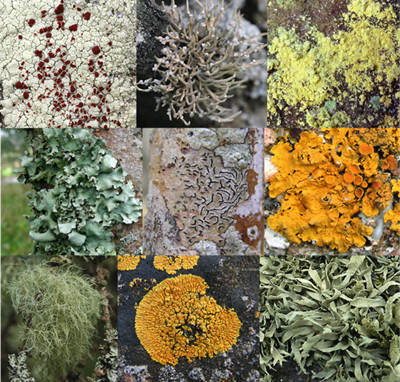(单词翻译:单击)
听力文本
This is Scientific American — 60-Second Science. I'm Christopher Intagliata.
Lichens. They're probably the most common example of two organisms living in a symbiotic relationship. There's a fungus and a photosynthesizing partner, like algae. It's a bond that was born, as they say, when "Alice Algae," took a "lichen" to "Freddie Fungus."
But that simple description covered up a larger mystery: how could two different lichen species combine the same building blocks—same fungus, same algae—"and yet they look very different, have very different chemistry, and some of them even have distinctly different ecology."
Toby Spribille, an evolutionary biologist at the University of Montana, and the University of Graz in Austria.
He and his colleagues studied two lichen species that fit that bill. Same underlying parts, different color and chemistry. They ground the lichens up, and then analyzed their RNA. What they expected to find was two genomes: one fungus, one alga. "And what we found is that, at the end of a lot of analysis, we had was three genomes, not two.And this was really surprising."

The third genome was from a type of yeast. And the more yeast was present, the more yellowish—and more toxic—the lichen was. The study appears in the journal Science.
But how could scientists spend so many years studying these lichens—and still miss this crucial third species? Spribille says it could have been the type of genetic sequencing. Previous studies relied on DNA barcodes, which only sample some of the genome, to identify the underlying fungus and alga. Sort of like identifying the occupants of a completely dark room by shouting out a few names and seeing who answers.
What Spribille did, instead, was just turn all the lights on, with whole genome sequencing, revealing the identity of all occupants, and in doing so, "we eliminated anything that required going in and calling out somebody's name so to speak."
As for whether some lichens might have four, five species? "I certainly wouldn't rule it out at this point." Because this study indicates lichens are truly more than the sum of their parts. Including, of course, the parts we still don't know about.
Thanks for listening for Scientific American — 60-Second Science Science. I'm Christopher Intagliata.
参考译文
这里是科学美国人——60秒科学。我是克里斯托弗·因塔利亚塔。
地衣可能是两种生物以共生关系存在的最常见例子。地衣由1种真菌和1种光合生物(如藻类)组成。这种联系是固有的,就像他们说的,“爱丽丝藻类”和“弗雷迪真菌”共生形成地衣。
但是这种简单的描述掩盖了一个更深奥的秘密:两种不同的地衣物种如何结合同样的成分——即同样的真菌和同样的藻类,“而且,它们看上去非常不同,它们的化学成分也不同,有些地衣甚至有着明显不同的生态。””
托比·斯普利比尔是蒙大拿大学和奥地利格拉茨大学的进化生物学家。
他和同事对符合上述条件的两种地衣进行了研究。这两种地衣的基本成分相同,但颜色和化学成分不同。他们将地衣磨碎,然后分析了它们的核糖核酸。他们原以为会发现两个基因组:一个是真菌,另一个是藻类。“但最后,在进行大量分析以后,我们发现的是三个基因组,而不是两个。这真是太让人惊讶了。”
第三个基因组来自于一种酵母。酵母的含量越多,地衣颜色越黄,毒性也越强。这项研究发表在《科学》杂志上。
但是,科学家们怎么会在研究地衣多年后仍未发现这至关重要的第三物种?斯普利比尔表示,可能是由于基因测序的方法不一样。此前的研究依赖于DNA条形码,只是对这一基因组中的一部分进行抽样调查,用以确认潜在的真菌和藻类。这就好像在一间完全黑暗的房间里,通过喊出几个名字,看看谁作出回答,来确定居住者身份。
而斯普利比尔的做法是,打开房间内所有的灯,通过全基因组测序来揭示所有居住者的身份,并且通过这种方法,“可以说,我们不需要进入房间喊出某人的名字。”
至于是否有地衣含有第四或第五种成分?“现在我不能完全排除这一可能性。”因为这项研究表明,地衣不仅仅是各部分的单纯相加。还包括我们目前尚不知道的成分。
谢谢大家收听科学美国人——60秒科学。我是我是克里斯托弗·因塔利亚塔。
译文为可可英语翻译,未经授权请勿转载!
重点讲解
重点讲解:
1. cover up 隐藏,遮掩(事实);
例句:He suspects there's a conspiracy to cover up the crime.
他怀疑有人密谋掩盖犯罪事实。
2. grind up 磨碎;碾碎;将…磨成粉;
例句:We grind up the wheat to make flour.
我们把小麦磨成面粉。
3. rely on 依赖;依靠;
例句:We must rely on ourselves, no other option.
我们必须依靠自己,没有其他选择.
4. shout out 大声说出;大声喊出;
例句:When I call your name, shout out so that we know you're here.
当我叫到你的名字时请大声响应, 以便大家知道你来了。
5. turn on 打开(设备);接通(…的供应);
例句:I want to turn on the television.
我想开电视。
6. so to speak 可以说;可谓;
例句:But for young people it presents an opportunity to follow the sun, so to speak.
但对年轻人来说,却可以说是追寻生活乐趣的良机。
7. rule out 排除;不予考虑;
例句:I think we can rule out the possibility of objection to us.
我认为我们可以排除有人反对我们的可能性。


